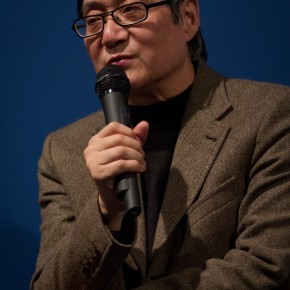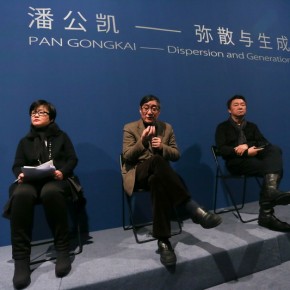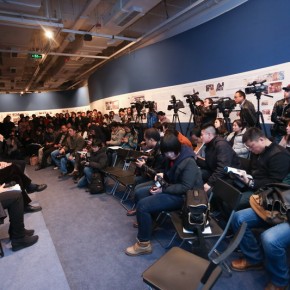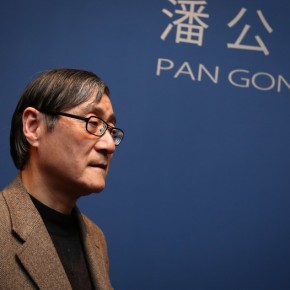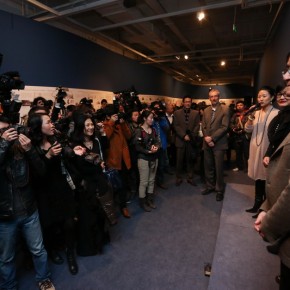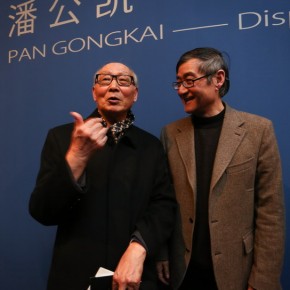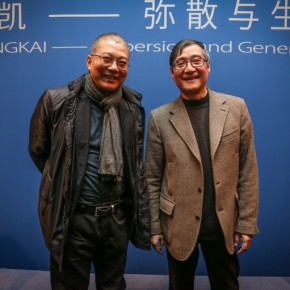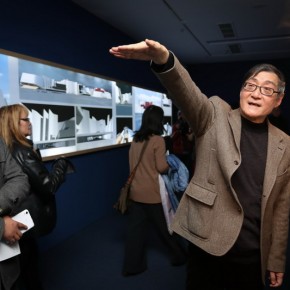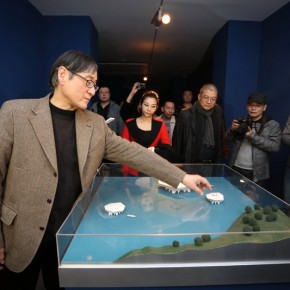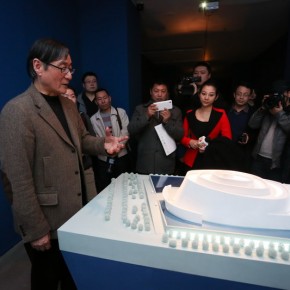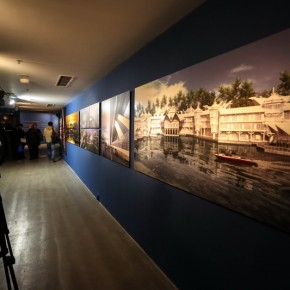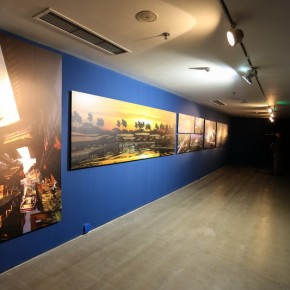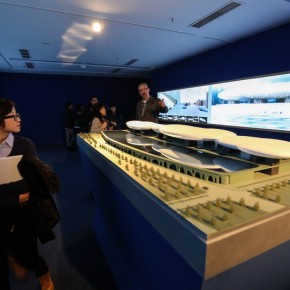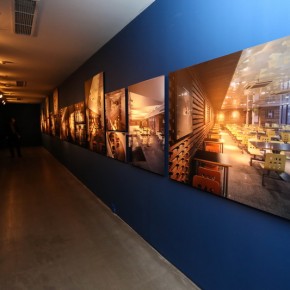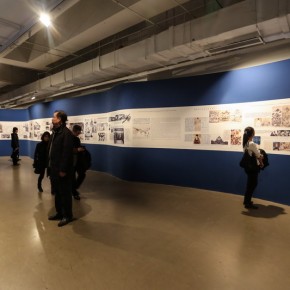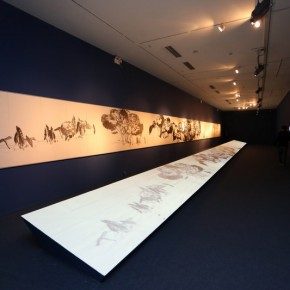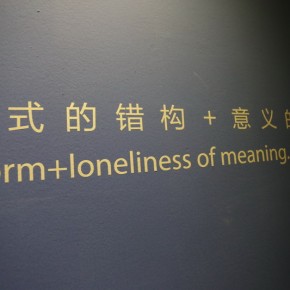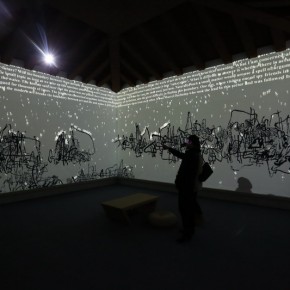
Jointly organized by Today Art Museum, the Sino-US Relations Center of Asia Society, and the Central Academy of Fine Arts, solo exhibition “Dispersion and Generation” of Pan Gongkai was grandly inaugurated at the Today Art Museum on the afternoon of March 9, 2013. The exhibition aimed to research and raise questions, under two key concepts of “dispersion and generation”, with the use of the core of the problem awareness, to stimulate discussion, criticism and debate, to promote the academic atmosphere in the present cultural context.
The press conference of the exhibition was held at 15:00 pm, on the 3rd floor of building 1, Today Art Museum, participant guests include: Xie Suzhen, Director of Today Art Museum, Professor Pan Gongkai, President of the Central Academy of Fine Arts, Fang Zhenning, a representative of the curatorial team of the exhibition, etc. The moderator introduced the artist’s thoughts on the key issues in the fields of ink and wash painting, installation, history and theory, and architecture, as well as the theatrical clues behind the cross-border experiments. This was not only a discussion of Pan Gongkai’s theoretical thinking over many years, but also a comprehensive reflection of his recent achievements of exploration. Xie Suzhen, Pan Gongkai, and Fang Zhenning respectively made their speeches. Xie Suzhen, Director of Today Art Museum initially admitted that she has a great admiration for Pan Gongkai’s achievement in ink and wash painting, and she was proud to be his student. She said what was impressive to her was that contemporary art was in negotiation and revolution, which should be the root of traditional media. Rooted on traditional ink and wash painting, Pan Gongkai’s works had developed into the fields of installation, multimedia, theory and architecture, etc.
Prof. Pan Gongkai presented an in-depth introduction on the title and content of the exhibition. He initially mentioned the issue of “cross-border”, because the exhibition covers four sections which looked unconnected to each other, and independent, Pan hoped to provoke a public analysis and discussion, taking his personal practice as a case. He stressed that it was not a retrospective, instead, an exhibition to raise questions on Chinese art, through which the public would raise and debate the questions when they were concerned with the exhibition.
When talked about the title “Dispersion and Generation”, firstly, Pan mentioned that “dispersion” is a fundamental concept in modern thermodynamics, which was used to describe the process of the heat that flowed in a closed space. The provision of the second law of thermodynamics is that heat flows from an area with a higher temperature to that with a lower temperature, which is irreversible, ultimately causing thermal balance in the space, reaching a status of high entropy. It is the process of dispersion.
Pan took culture as “dispersion”, in the cultural context of “dispersion”, how did it make a new “generation” in the art and culture, which was the starting point of his artistic thinking and practice. The overwhelming dispersion makes the generation difficult, but also makes it a target which is truly worthy of exploration for the artist of a global vision.
Following Fang Zhenning spoke as a representative of the curatorial team, and summed up three points: Firstly, how to evaluate his artistic achievements such as art creation and architecture design? Fang Zhenning said he was the whole of an artist, art historian, architect, designer, and educator, and suggested that there should be a subtitle: Pan Gongkai’s Art Aircraft Carrier for the exhibition. Secondly, Pan Gongkai had held a lot of exhibitions, the additional section of architecture revealed his “secret love” of architecture. Fang said Prof. Pan had designed six architecture projects, from interior design to architecture design and urban planning. Thirdly, the section of the third floor was very important: a combination of two generations. Because Pan Gongkai was the son of Pan Tianshou, who wrote the history of Chinese painting, he continued his father’s work and made a great contribution to Chinese modern and contemporary art.
The opening ceremony was held on the third floor of building 1, at 16:00 pm, Xie Suzhen, Director of the museum, Shao Dazhen, a famous theorist and professor at the Central Academy of Fine Arts, and Prof. Pan Gongkai presented. Wei Ershen, President of the Lu Xun Academy of Fine Arts, Xu Jiang, President of the China Academy of Art, and etc. were invited to participate in the opening ceremony.
Prof. Shao Dazhen said, this exhibition had an in-depth subject, and Pan’s ideology, views, and concepts were a unity. After reforming and opening up, he ran towards the world away from the Chinese art circles, observing the art all over the world, and thinking deeply about present Chinese traditional fine arts. Comparing them, he came to a very complicated conclusion of academic meaning. The so-called “dispersion” actually referred to the ideological trend of global contemporary art that the Western ideological trend spread through the world. There were many new things, along with many ill miscellaneous items. “Generation” was the fruit dimly seen in the process of “dispersion”, which was in need of constant research and desire. This theme is reflected in the sections of his exhibition. Shao stressed what Pan Gongkai had said, the purpose of organizing this exhibition, rather than telling people the results, he hoped to share his thoughts with others, and thoughts together. In today, art in China was in a complicated and rich process. The collision between Chinese and Western modern arts produce a lot of problems which were difficult to understand. Shao believed that Pan was a very serious, diligent thinking theorist and artists. Finally, he said, rather than the result, this exhibition inspired people to think of contemporary art in China at a deeper level.
The exhibition will remain on view at Today Art Museum until March 31, 2013. In addition, several sections of academic discussions are being held at the Today Art Museum and Beijing University in mid and late March, some important domestic and foreign artists, experts and scholars are invited to participate in them. In-depth discussions about the issues and thoughts proposed at the exhibition were the object of the discussions, together with the publications, to be the organic extension of the exhibition.
Reported by? Gao Sisi and translated by Chen Peihua
Photo by? Hu Zhiheng and edited by Sue/CAFA ART INFO


